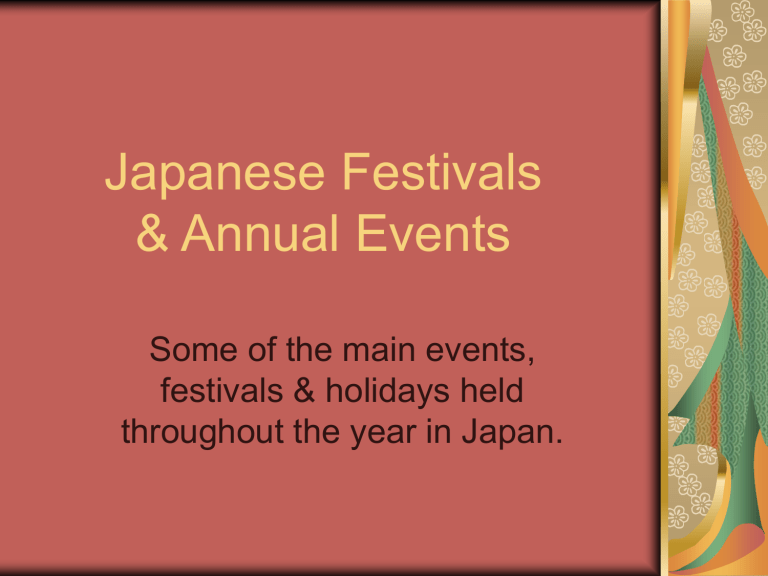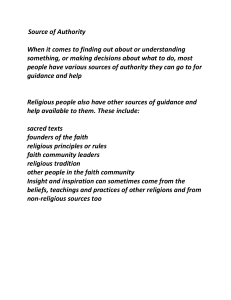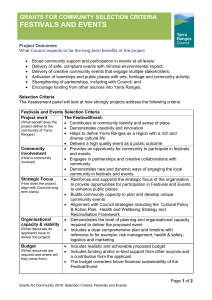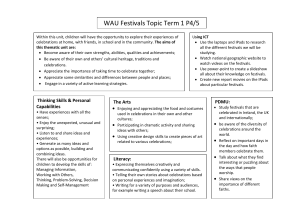
Japanese Festivals & Annual Events Some of the main events, festivals & holidays held throughout the year in Japan. Japanese Festivals & Annual Events Children’s Day Coming-of-Age Day Cherry Blossom Watching New Year Festivals in your Country What are the main festivals in Ireland? St. Patrick’s Day Easter Halloween Christmas Some Japanese National Holidays & Festivals New Year’s Day: Gantan or OShogatsu Coming-of-Age Day: Seijin No Hi Valentine's Day & White Day Girl’s Day: Hina Matsuri Cherry Blossom Viewing: Hanami Children’s Day: Kodomo no Hi Shichi-Go-San O-Shogatsu/New Year O-Shogatsu is the most important festival in the year. Most places close from Dec 29Jan 3. Jan 1st is called Gantan. Millions of people return to their family homes for the celebrations. People send each other postcards known as Nengajou. Houses are decorated with special decorations, and food is prepared & stored in lacquer boxes. People visit Shrines to give thanks for the year and to pray for a good new year. Children get money presents known as O-toshidama. Kadomatsu Hatsumode Seijin no Hi/Coming-of-Age Day It is held on the second Monday of January. It is for people who turned 20 in the previous year. The legal age to drink and vote in Japan is 20. Ceremonies are held at the local government offices. Girls dress in elaborate kimono called furisode. Boys wear traditional kimono called hakama or suits. Everyone goes out to party after the ceremonies. Valentines Day & White Day On Valentines Day, Feb 14th, women give men (teachers, colleagues, friends) chocolates in Japan! Chocolates given to men at work are called Giri-Choco (obligation chocolate). Younger people have adopted the Western approach and often book expensive meals and give their boyfriend/girlfriend presents. White Day is held on March 14th. It is the mans turn to give women presents of white chocolate, biscuits, jewellery, and lingerie. The white day present is usually more expensive than the Valentine’s present. Hina Matsuri: Girl’s Day Held on March 3rd, it is known as Girl’s Day or Doll’s Festival. Families with girls set up a selection of dolls Hina-ningyou on a red platform around midFebruary. The top 2 dolls are the Emperor & Empress. Special sweets, cakes, rice crackers, and sushi are eaten, and sweet sake is drunk. Hanami: Cherry Blossom Viewing Hanami means flower watching but it occurs when the Cherry Blossoms are in bloom around late March to early April. People gather in parks under trees or by river banks to have picnics. They often bring karaoke machines & sing & dance until late. There is quite a bit of competition to get the best places under the most beautiful trees. Kodomo No Hi/Children’s Day Held on May 5th, this is a national holiday. It was traditionally called Boy’s Day. Decorations include Koi (carp) Streamers and samurai helmets and dolls. These symbolise strength, success, and power. Obon Traditionally held in midJuly, though some areas have Obon in August. It is 2nd biggest event after New Year. Most people return to their family homes during this time. At Obon it is said that spirits of dead ancestors return to their homes. People clean their relative’s graves & light a path to the house. Summer Festivals Hanabi/Fireworks Taiko Drummers Girls in Yukata Yakisoba/Fried Noodles A few more festivals………… Shichi-Go-San Shichi-go-san is a festival for children of 7yrs(girls), 5yrs (boys) and 3yrs (mainly girls). Held on November 15th. Children are dressed in kimono and brought to a Shrine to pray. They receive Chitose Ame literally "thousand year candy", on Shichi-Go-San. It is long, thin, red and white and it symbolizes healthy growth and longevity. It is given in a bag with a crane and a turtle on it, which represent long life in Japan.




